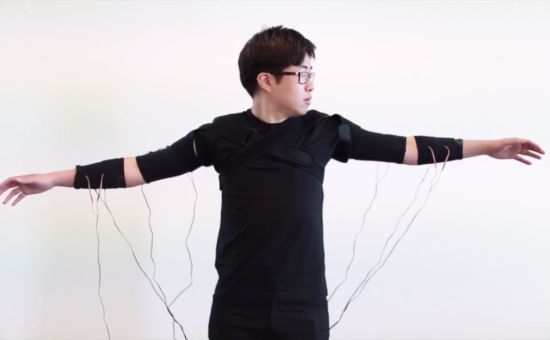
Out With the New, in With the Old: Futuristic Ideas Powered by Ancient Tech

There’s something satisfying about swishy new tech borrowing from concepts from the past. It has a hint of the retro without being gimmicky. Keen to find out what hidden treasures other future-facing types have found in the past we caught with Yifei Chai, Creative Director at UNIT9. He’s an innovator with backgrounds in art and engineering, and a soft spot for old forgotten technologies that have been reborn in the modern age. Here he talks LBB’s Alex Reeves through some of his favourite examples.
“A lot of people tend to think innovation is about creating new things,” says Yifei, pondering how old ideas find new life in the modern world. “But I think innovation is about putting things together that haven’t been put together before. If you look at the top chefs in the world, they’ll never be able to invent a new species of fish to create a new dish. Innovation is about trying out different combinations. And that’s how in the early stages of human society we created alchemy. Innovation is very similar to alchemy.”
The Pretender Project
The Pretender Project from UNIT9 on Vimeo.
Developed as part of Yifei’s studies for his Double Masters degree at Royal College of Art and Imperial College London (MA/MSc Innovation Design Engineering), the Pretender Project delivers on a prediction long made by fiction. “We’ve all watched sci-fi movies where you can take over another person’s body,” he says. “And this a technology that literally is able to do that. It’s a two-part system. It uses virtual reality, which is itself a little bit dated in terms of its technology. It was first in the ‘80s that people really started to talk about VR.
“But that isn’t the oldest part of it. The virtual reality allows you to see through another person’s eyes, but this alone is not able to create a new experience - we’ve all seen POV videos before. The main difference is that in normal POV videos you’re a passenger, so whatever has been recorded is already there, whereas with the Pretender Project combining it with muscle stimulation you are able to physically take control of another person’s body. However you move, you stimulate the other person’s muscles to move in exactly the same manner.”
The technology that allows this is called electrical muscle stimulation (EMS), which was first proven by Luigi Galvani in 1761. “It’s common, even in schools,” says Yifei. “Dissecting frogs, you zap its leg and the leg contracts, you know?” Yifei has fine-tuned that process to allow very detailed, accurate motion to be triggered through electrical pulses, essentially copying the same electrical stimulation that’s coming from the brain down to the muscle.
“Combining this relatively old technology with virtual reality, you have the early potential of being able to take over another person’s body,” he says. “We have a prototype that allows me to control another person’s upper torso as well as the forearm. We’ve been touring it around and it’s had good responses from people who’ve tried it.”
Since the project began in 2014 it has received government funding to push it forward, but also some disturbing enquiries from military. “They wanted to use this for body enhancement, body armour and stuff like that,” he says. “We never pursued that because it’s a little bit scary to see what the military want to do with this.”
Photogrammetry and Volumetric Videos
Virtual Reality is still broadly split into two categories: 360 video, which is photorealistic but doesn’t allow users to control or manipulate anything, and 3D experiences built in a game engine and live rendered, which give users control, but don’t look so realistic.
New camera rigs might have found the perfect compromise, having looked to the past for inspiration. “Volumetric video is such a cutting-edge technology but it uses something that even outdates 3D,” says Yifei. A 360-degree array of cameras takes a photo of an object from multiple angles and then that to stitch them into a 3D object.
“The texture is just a photo or video, but stretched over a 3D mesh,” he says. “When the first camera came out there were no 3D engines to even allow you to create a cube. Now technology has allowed such an old technique of simply taking a photo to wrap it into a virtual 3D space and create a hyper-realistic 3D model. This is also a good example of how new technology has helped old technology to rejuvenate and become relevant even in these futuristic times of virtual reality and 3D engines.”
Silk Leaf
In the same year that Yifei graduated from the Royal College of Art, a colleague of his created something that really impressed him. It’s called Silk Leaf by Julian Melchiorri.http://www.julianmelchiorri.com/Silk-Leaf
“Julian extracted all the photosynthesis cells [called chloroplasts] from inside plants,” explains Yifei. “Then he used silk pulp to create a plastic shell in the shape of a leaf and filled this shell with photosynthesis cells.”
It had to be silk because of it’s perfect combination of properties allowing oxygen, CO2 and water to seep through. It also preserves the chloroplasts so they don’t decay. As Yifei puts it, “he created an artificial leaf using purely natural materials that never decays.”
The applications Melchiorri envisioned for his leaf material are the stuff of utopian fantasy worlds. “This could potentially become wallpaper or building tiles,” enthuses Yifei. “Imagine the surface of a wall completely covered with these tiles. In the future you’d be able to utilise all the sunshine that’s shining on a building to generate oxygen.” Imagine applications for this product in space, transforming light into oxygen to help sustain human life.
Some of the scientific community seems sceptical about whether the Silk Leaf can work as Melchiorri promises, http://www.zmescience.com/ecology/green-living/silk-leaf-first-biological-leaf-055343/ but either way it’s a fascinating potential application for silk, a substance in human use for thousands of years. And with no moving parts it’s an elegant one, too.
The World’s Most Beautiful Library
Another use for old tech that’s got Yifei in a reverie is Light Fidelity or Li-Fi, which is pretty much what it sounds like - Wi-Fi, but using light. The term was coined by University of Edinburgh Professor Harald Haas during a TED Talk in 2011. “It’s essentially an LED that not only lights up stuff but also transfers information,” explains Yifei.
The reason Li-Fi is able to act like Wi-Fi is because LEDs, unlike normal light bulbs, are able to turn on and off very fast. Dimmable LED lights are actually pulsing, but because the human eye can’t perceive them turning on and off very fast you think that it’s the brightness of the light that’s changing. So if you can pulse LED at that speed, it’s essentially able to pass information in the form of binary, 0s and 1s.
In 2012, after four years of research, Haas set up the company pureLiFi with the aim 'to be the world leader in Visible Light Communications technology'.“They still haven’t found a way to use this technology,” says Yifei, disappointed, “but from my point of view it’s a really beautiful object because it makes information visible. Digital information right now is invisible. You can’t quantify it, but with this you can actually see data. I think there’s something very poetic about it.”
His dream for the technology is something he calls ‘The World’s Most Beautiful Library’: A massive open space with spotlights in, each transmitting an e-book through Li-Fi to a receiving device “All you would need to do is stand under the spotlight and you’d be able to read the book carried by the information that the light contains,” he says. “Even though these books are digital, we would give them a physical presence.”
Li-Fi can also be used for security and privacy. “Wi-Fi often gets hacked because you don’t physically see where it’s going,” he says. “Whereas with Li-Fi, the area the light reaches is the full extent of where the information is [accessible]. So if you build a windowless meeting room with a Li-Fi in and all this information is transferred through light you’re pretty sure that no-one else outside the room would be able to access this.”
Ancient Gestures
One technology Google have been pouring resources into recently is gesture control, a la Minority Report, but the science that could end up making it a reality is surprisingly un-futuristic. Soli is a sensor technology that uses radar - a technique dating back over 100 years - to detect minute hand motions without contact.
Typewriters… of the Future
Yifei is enchanted by the idea of finding future solutions in old ideas. He remembers a story he once heard that inspired him: “Essentially, this guy took a typewriter to a bunch of kids and asked them what they thought it was. The kids came to a conclusion that this was a computer of the future. It didn’t use any electricity, so you didn’t need to plug it in and then whatever you typed directly came printed out.”
It’s a parable for creative technologists obsessed with the latest advancements in hardware and software. “For someone who knows the advancement of technology, the typewriter seems so outdated,” he says. “But if you give it to someone with a fresh eye it has some attributes that potentially exceed even current standards.”
The story got Yifei thinking about the merits of typewriters. For example, you’d think the invention of word processors and printers would save paper, because suddenly making a mistake didn’t mean throwing away a whole sheet. “Actually, the inventor of the computer caused the waste of paper to dramatically increase,” he considers.
“People talk about innovation as the golden key that will unlock our future,” says Yifai. But innovation doesn’t fall from the sky like a meteor and instantly change the world. “I would say collaboration and revisiting old knowledge, using today’s thinking to expand to the future is what human innovation is actually about.” In this age of future-philes, maybe it pays to look back.













